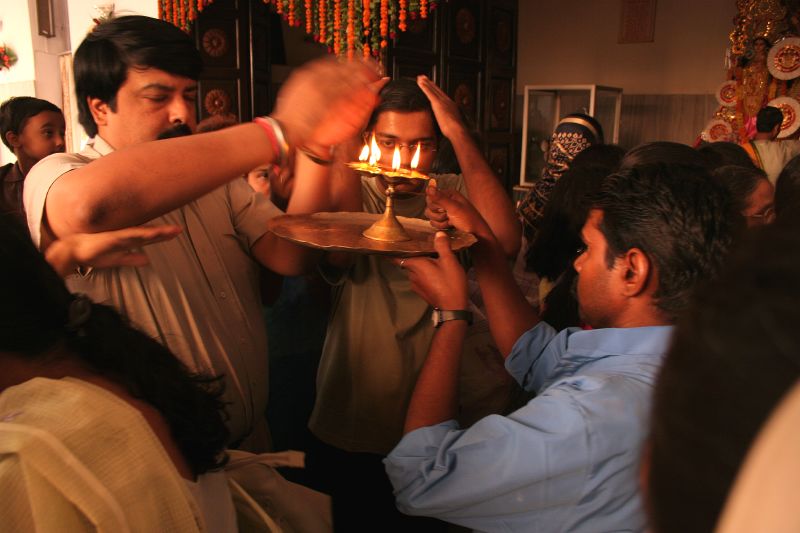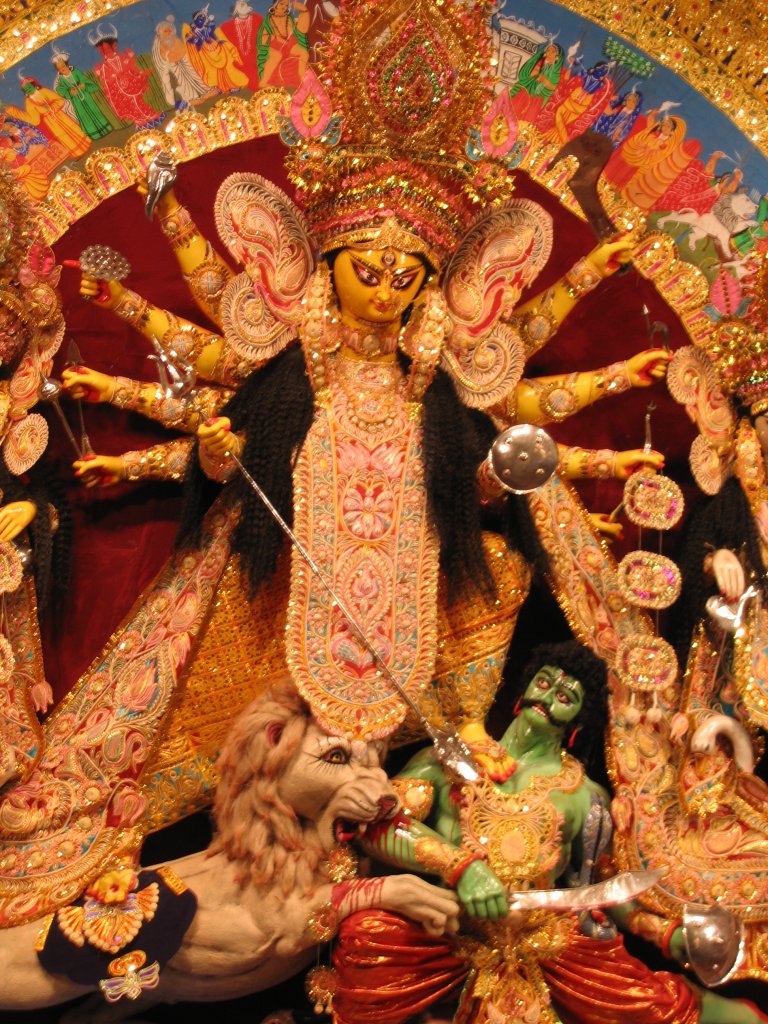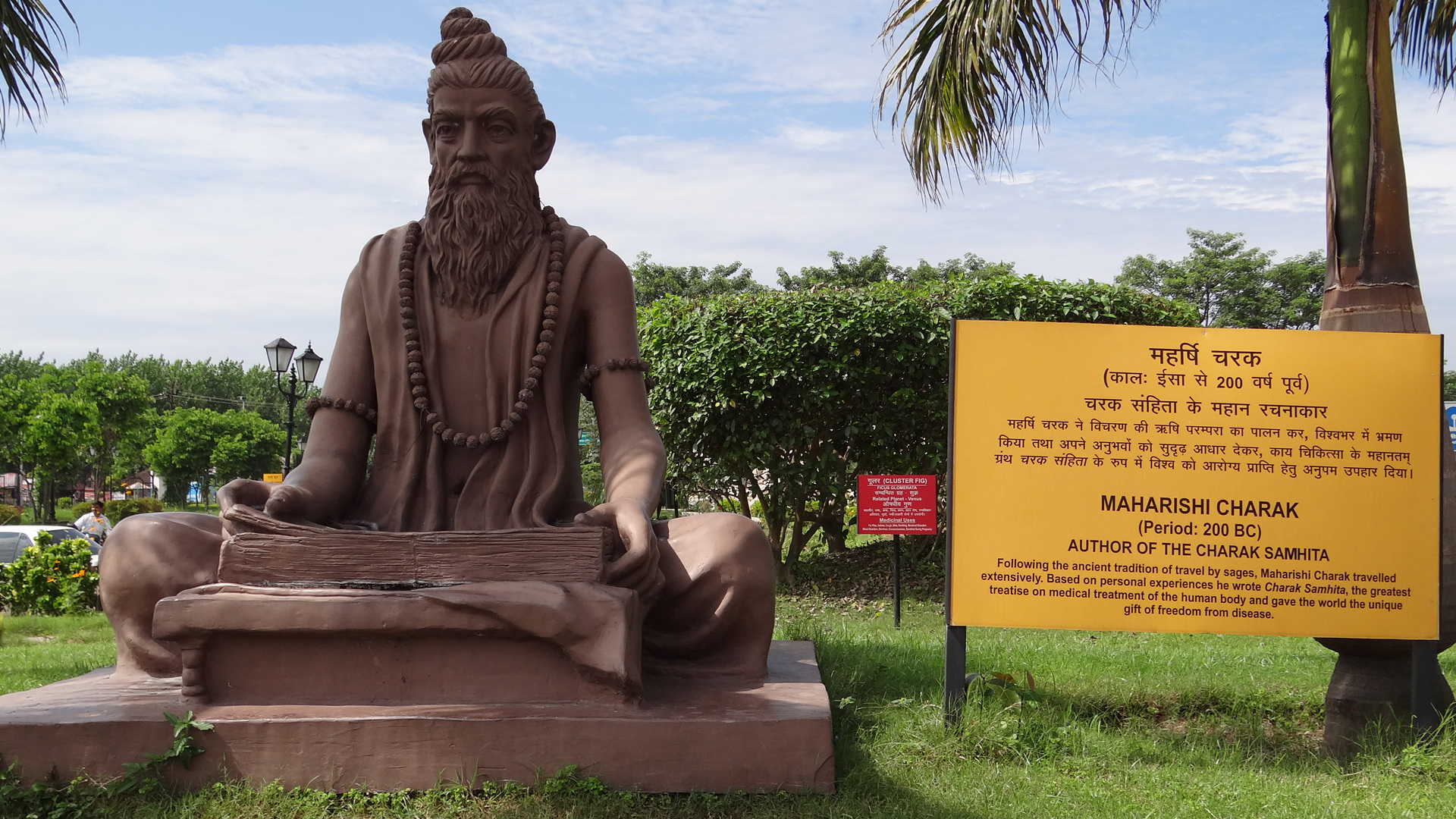|
Mantrapushpanjali
Mantrapushpanjali (Sanskrit, Devanagari मंत्रपुष्पांजलि, IAST ''mantrapuṣpāñjali'') is a popular prayer in India, it is the unique prayer of hindus and it means “offering flowers in the form of mantra”. It comprises four hymns from Vedic sources, and is the final prayer sung at the end of āratīs. The word Mantrapushpanjali is made up of three elements, ''mantra'' (incantation), pushpa (flower), and anjali (a bowl-shaped cavity formed by hollowing and joining open palms together, as when offering or receiving alms). Mantrapushpanjali is an appendix of a set of traditional recital called Deve (Sanskrit, Devanagari देवे ) from Shukla Yajurveda branch of Vedic tradition. The hymns of Mantrapushpanjali are chanted at an extremely slow pace, elongating all the deergha svarit (Sanskrit, Devanagari दीर्घस्वरित) accents more than usual. Text ॐ यज्ञेन यज्ञमयजन्त देवास् ... [...More Info...] [...Related Items...] OR: [Wikipedia] [Google] [Baidu] |
Āratī
''Arti'' () or ''Aarati'' () is a Hindu ritual employed in worship, part of a '' puja'', in which light from a flame (fuelled by camphor, ghee, or oil) is ritually waved to venerate deities. ''Arti'' also refers to the hymns sung in praise of the deity, when the light is being offered. Sikhs have ''Arti'' ''kirtan'' which involves only devotional singing; the Nihang order of Sikhs also use light for ''arti''. Etymology and origin ''Aarti'' is thought to have descended from ''Vedic'' ''fire rituals or yajna''. ''Aarati'' is derived from the Sanskrit word () which means something that removes , “darkness”.James Lochtefeld, An illustrated Encyclopedia of Hinduism, , page 51 A Marathi language reference says it is also known as (). According to Steven Rosen, ''arti'' means "before night" or symbolic end of the night to the worshipper's "material sojourn - he or she is now situated in the light of God's devotion."Rosen, Steven (2006). ''Essential Hinduism''. Praeger Publishers ... [...More Info...] [...Related Items...] OR: [Wikipedia] [Google] [Baidu] |
Sanskrit
Sanskrit (; stem form ; nominal singular , ,) is a classical language belonging to the Indo-Aryan languages, Indo-Aryan branch of the Indo-European languages. It arose in northwest South Asia after its predecessor languages had Trans-cultural diffusion, diffused there from the northwest in the late Bronze Age#South Asia, Bronze Age. Sanskrit is the sacred language of Hinduism, the language of classical Hindu philosophy, and of historical texts of Buddhism and Jainism. It was a lingua franca, link language in ancient and medieval South Asia, and upon transmission of Hindu and Buddhist culture to Southeast Asia, East Asia and Central Asia in the early medieval era, it became a language of religion and high culture, and of the political elites in some of these regions. As a result, Sanskrit had a lasting effect on the languages of South Asia, Southeast Asia and East Asia, especially in their formal and learned vocabularies. Sanskrit generally connotes several Indo-Aryan languages# ... [...More Info...] [...Related Items...] OR: [Wikipedia] [Google] [Baidu] |
Taittiriya Aranyaka
The ''Aranyakas'' (; ; IAST: ') are a part of the ancient Indian Vedas concerned with the meaning of ritual sacrifice, composed in about 700 BC. They typically represent the later sections of the Vedas, and are one of many layers of Vedic texts. The other parts of the Vedas are the Samhitas (benedictions, hymns), Brahmanas (commentary), and the Upanishads (spirituality and abstract philosophy).A Bhattacharya (2006), Hindu Dharma: Introduction to Scriptures and Theology, , pages 8-14 ''Aranyakas'' describe and discuss rituals from various perspectives; some include philosophical speculations. For example, the Katha Aranyaka discusses rituals connected with the '' Pravargya''. The Aitareya Aranyaka includes explanation of the ''Mahavrata'' ritual from ritualisitic to symbolic meta-ritualistic points of view. ''Aranyakas'', however, neither are homogeneous in content nor in structure. ''Aranyakas'' are sometimes identified as ''karma-kanda'' (कर्मकाण्ड), ritualis ... [...More Info...] [...Related Items...] OR: [Wikipedia] [Google] [Baidu] |
Ganesh Festival
Ganesh Chaturthi (ISO 15919, ISO: ), also known as Vinayaka Chaturthi () or Vinayaka Chavithi () or Vinayagar Chaturthi (), is a Hindu festival celebrating the birthday of Hindu deities, Hindu deity Ganesha, Ganesh. The festival is marked with the installation of Ganesha's ''murtis'' (devotional representations of a deity) privately in homes and publicly on elaborate pandals (temporary stages). Observances include chanting of Vedic hymns and Hindu texts, such as prayers and ''vrata'' (fasting). Offerings and ''prasada'' from the daily prayers, that are distributed from the pandal to the community, include South Asian sweets, sweets such as ''modak'' as it is believed to be a favourite of Ganesha. The festival ends on the tenth day after start, when the ''murti'' is carried in a public procession with music and group chanting, then immersed in a nearby body of water such as a river or sea, called ''visarjana'' on the day of Anant Chaturdashi, Ananta Chaturdashi. In Mumbai alone, a ... [...More Info...] [...Related Items...] OR: [Wikipedia] [Google] [Baidu] |
Durga
Durga (, ) is a major Hindu goddess, worshipped as a principal aspect of the mother goddess Mahadevi. She is associated with protection, strength, motherhood, destruction, and wars. Durga's legend centres around combating evils and demonic forces that threaten peace, prosperity, and dharma, representing the power of good over evil. Durga is believed to unleash her divine wrath against the wicked for the liberation of the oppressed, and entails destruction to empower creation. Durga is seen as a motherly figure and often depicted as a beautiful woman, riding a lion or tiger, with many arms each carrying a weapon and often defeating demons. She is widely worshipped by the followers of the goddess-centric sect, Shaktism, and has importance in other denominations like Shaivism and Vaishnavism. The most important texts of Shaktism, Devi Mahatmya and Devi Bhagavata Purana, revere Devi (the Goddess) as the primordial creator of the universe and the Brahman (ultimate truth and reali ... [...More Info...] [...Related Items...] OR: [Wikipedia] [Google] [Baidu] |
Shiva
Shiva (; , ), also known as Mahadeva (; , , Help:IPA/Sanskrit, [mɐɦaːd̪eːʋɐh]) and Hara, is one of the Hindu deities, principal deities of Hinduism. He is the God in Hinduism, Supreme Being in Shaivism, one of the major traditions within Hinduism. Shiva is known as ''The Destroyer'' within the Trimurti, the Hinduism, Hindu trinity which also includes Brahma and Vishnu. In the Shaivite tradition, Shiva is the Supreme Lord who creates, protects and transforms the universe. In the goddess-oriented Shaktism, Shakta tradition, the Supreme Goddess (Devi) is regarded as the energy and creative power (Shakti) and the equal complementary partner of Shiva. Shiva is one of the five equivalent deities in Panchayatana puja of the Smarta Tradition, Smarta tradition of Hinduism. Shiva has many aspects, benevolent as well as fearsome. In benevolent aspects, he is depicted as an Omniscience, omniscient yogi who lives an Asceticism#Hinduism, ascetic life on Kailasa as well as a house ... [...More Info...] [...Related Items...] OR: [Wikipedia] [Google] [Baidu] |
Ganesh
Ganesha or Ganesh (, , ), also known as Ganapati, Vinayaka and Pillaiyar, is one of the best-known and most worshipped Deva (Hinduism), deities in the Hindu deities, Hindu pantheon and is the Supreme God in the Ganapatya sect. His depictions are found throughout India. Hindu denominations worship him regardless of affiliations. Devotion to Ganesha is widely diffused and extends Ganesha in world religions, to Jains and Buddhists and beyond India. Although Ganesha has many attributes, he is readily identified by his Asiatic Elephant, elephant head and four arms. He is widely revered, more specifically, as the remover of obstacles and bringer of good luck; the patron of The arts, arts and Science, sciences; and the Deva (Hinduism), deva of intellect and wisdom. As the god of beginnings, he is honoured at the start of rites and ceremonies. Ganesha is also invoked during writing sessions as a patron of letters and learning., Vigna means obstacles Nasha means destroy. These ideas ar ... [...More Info...] [...Related Items...] OR: [Wikipedia] [Google] [Baidu] |
Horse Offering
The horse (''Equus ferus caballus'') is a domesticated, one-toed, hoofed mammal. It belongs to the taxonomic family Equidae and is one of two extant subspecies of ''Equus ferus''. The horse has evolved over the past 45 to 55 million years from a small multi-toed creature, ''Eohippus'', into the large, single-toed animal of today. Humans began domesticating horses around 4000 BCE in Central Asia, and their domestication is believed to have been widespread by 3000 BCE. Horses in the subspecies ''caballus'' are domesticated, although some domesticated populations live in the wild as feral horses. These feral populations are not true wild horses, which are horses that have never been domesticated. There is an extensive, specialized vocabulary used to describe equine-related concepts, covering everything from anatomy to life stages, size, colors, markings, breeds, locomotion, and behavior. Horses are adapted to run, allowing them to quickly escape predators, and possess ... [...More Info...] [...Related Items...] OR: [Wikipedia] [Google] [Baidu] |
Aitareya Brahmana
The Aitareya Brahmana () is the Brahmana of the Shakala Shakha of the Rigveda, an ancient Indian collection of sacred hymns. This work, according to the tradition, is ascribed to Mahidasa Aitareya. Authorship Sayana of Vijayanagara, a 14th century commentator, attributes the entire ''Aitareya Brahmana'' to a single man: Mahidasa Aitareya. In his introduction to the text, Sayana suggests that "Aitareya" is a matronymic name. Mahidasa's mother was "Itarā" (इतरा), whose name is derived from the Sanskrit word "itara". She was one of the wives of a great rishi (sage). The rishi preferred sons from his other wives over Mahidasa. Once he placed all his other sons on his lap, but ignored Mahidasa. On seeing tears in the eyes of her son, Itara prayed to the earth goddess Bhūmi, her kuladevi (tutelary deity). Bhūmi then appeared and gifted Mahidasa the knowledge contained in the ''Aitareya Brahmana''. Mahidasa is mentioned in other works before Sayana, such as the ''Chandogy ... [...More Info...] [...Related Items...] OR: [Wikipedia] [Google] [Baidu] |
Atharvaveda
The Atharvaveda or Atharva Veda (, , from ''wikt:अथर्वन्, अथर्वन्'', "priest" and ''wikt:वेद, वेद'', "knowledge") or is the "knowledge storehouse of ''wikt:अथर्वन्, atharvans'', the procedures for everyday life".Laurie Patton (2004), "Veda and Upanishad," in ''The Hindu World'' (Editors: Sushil Mittal and Gene Thursby), Routledge, , page 38 The text is the fourth Veda, and is a late addition to the Vedic scriptures of Hinduism.Laurie Patton (1994), ''Authority, Anxiety, and Canon: Essays in Vedic Interpretation,'' State University of New York Press, , page 57 The language of the Atharvaveda is different from Rigvedic Sanskrit, preserving pre-Vedic Indo-European archaisms. It is a collection of 730 Music of India#History, hymns with about 6,000 mantras, divided into 20 books.Maurice Bloomfield''The Atharvaveda'' Harvard University Press, pages 1-2 About a sixth of the Atharvaveda texts adapt verses from the Rigveda, and exce ... [...More Info...] [...Related Items...] OR: [Wikipedia] [Google] [Baidu] |
Kubera
Kubera (, ) also known as Kuvera, Kuber and Kuberan, is the god of wealth, and the god-king of the semi-divine yakshas in Hinduism. He is regarded as Guardians of the directions, the regent of the north (''Dikpala''), and a protector of the world (''Lokapala''). His many epithets extol him as the overlord of numerous semi-divine species, and the owner of the treasures of the world. Kubera is often depicted with a plump body, adorned with jewels, and carrying a money-pot and a club. Originally described as the chief of evil spirits in Veda, Vedic-era texts, Kubera acquired the status of a ''Deva (Hinduism), deva'' (god) only in the Puranas, ''Purana''s and the Hindu epics. The scriptures describe that Kubera once ruled Lanka, but was overthrown by his half-brother Ravana, later settling in the city of Alaka in the Himalayas. Descriptions of the "glory" and "splendour" of Kubera's city are found in many scriptures. Kubera has also been assimilated into the Buddhist and Jain pa ... [...More Info...] [...Related Items...] OR: [Wikipedia] [Google] [Baidu] |








